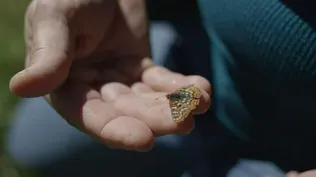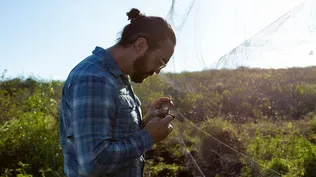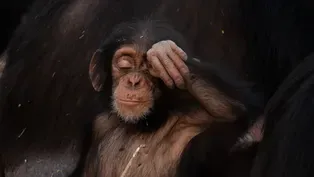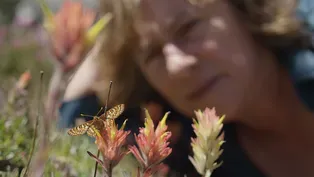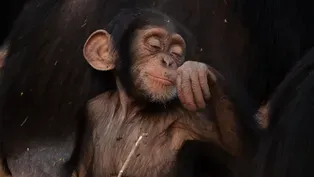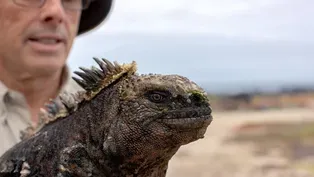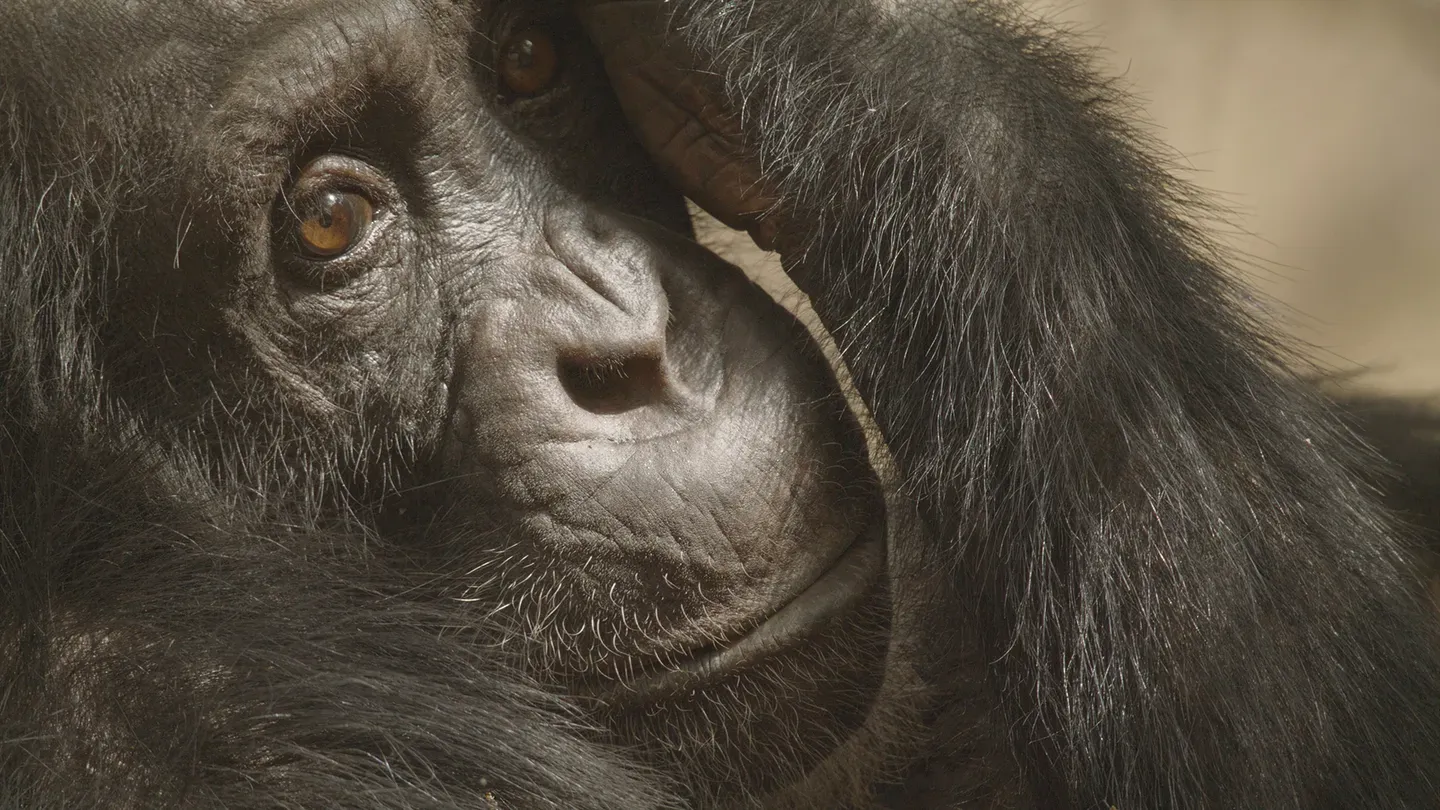

Earth
Episode 1 | 55m 26sVideo has Closed Captions
Animals have a surprising story to tell about our rapidly changing planet.
At Earth’s extremes, animals are reacting in surprising ways. Animal homes are changing around them at superspeed. Follow remarkable stories of resilience and hope. From humpback whales to tiny butterflies to ingenious savanna chimpanzees.

Earth
Episode 1 | 55m 26sVideo has Closed Captions
At Earth’s extremes, animals are reacting in surprising ways. Animal homes are changing around them at superspeed. Follow remarkable stories of resilience and hope. From humpback whales to tiny butterflies to ingenious savanna chimpanzees.
How to Watch Evolution Earth
Evolution Earth is available to stream on pbs.org and the free PBS App, available on iPhone, Apple TV, Android TV, Android smartphones, Amazon Fire TV, Amazon Fire Tablet, Roku, Samsung Smart TV, and Vizio.
Buy Now
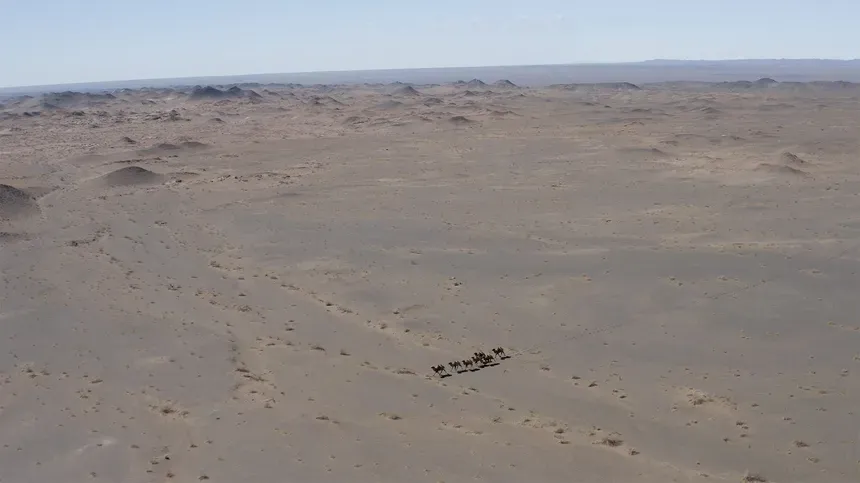
Evolution Earth
Traveling to the far corners of the world, we discover the extraordinary ways animals are adapting to our rapidly changing planet. We witness nature’s remarkable resilience, as our perception of evolution and its potential is forever transformed. Read these interviews with experts to learn more.Providing Support for PBS.org
Learn Moreabout PBS online sponsorship♪ [Shane Campbell-Staton] Our modern Earth is changing, and I mean fast, at speeds not seen for millions of years.
And all over the planet, animals are reacting... even evolving to keep pace with that change.
And this is a global story, but it starts here with our closest relatives.
These chimps are being pushed to do extraordinary things.
As they face their future... we reflect on our own evolutionary past.
♪ ♪ [Thunder] My name's Shane Campbell-Staton.
I'm an evolutionary biologist.
I'm here to tell you stories from filmmakers, scientists, and local experts across the globe about a pulse of change.
The entire planet is shifting.
The climate is changing at an incredible 170 times faster than it should be.
We can't always see it, we're so caught up in our own thing, you know, but the signs are everywhere.
♪ The entire tree of life is whispering to us.
We just have to pay attention.
Out there, things aren't what you expect.
You'll see.
[birds chirping] When you think about it, it makes sense that animals have a story to tell about the world around us.
I mean, life is constantly adapting to its environment.
To survive, you got to move with the times.
Over countless generations, these savanna chimpanzees have changed their behavior to deal with extreme temperatures.
No chimp lives in a hotter, drier place than this.
Temperatures in the Fongoli region already top 110 degrees, and it can go for 6 months without a single drop of rain.
Man, I get hot just looking at this.
♪ Most chimps live in lush forests much further to the south.
You got to be a specific kind of hardcore to make it like this.
[chimpanzees hooting] We caught up with a few special people, who need to be just as hardcore as the chimps.
Sorry.
There's tons of sweat bees flying in my eye.
[Shane] Primatologist Jill Preutz and her team have been following this group in Senegal for over 20 years.
[Jill] It was just remarkable to me when I got to Senegal, and I'm like, "Chimps don't live here."
Ha ha ha!
"This doesn't seem right."
And so, they do, and they seem fine.
They deal with it better than I do for sure.
[Shane] When you speak to Jill, you really get a sense of how deeply she loves them, so I asked her how have these chimps changed to survive in this scorched world?
How are they different from their forest cousins?
I mean, it's clear they've got far fewer resources at hand... and first up... [Jill] They have a huge home range up to 10 times bigger than chimps that live in forests.
[Shane] Hiking up to nearly 10 miles a day to find food in the intense heat, it's got to wear you down.
And unlike their jungle cousins, these savanna chimps have to travel mostly on the ground.
[chimpanzees hooting] [Jill] Nickle's juvenile daughter wants her to carry her, as well as her infant son, so Nickle now has a baby that she's carrying on her belly and a baby that she's carrying on her back.
[Shane] Now you can't really blame the little one here.
I'd probably want a ride, too.
Today, this is where they're headed, a secret larder hiding a vital source of protein... if you can get inside.
Termites.
♪ Struggle breeds innovation, you know, and these chimps have a neat trick.
♪ ♪ Watch and learn, my friend.
When researchers first saw chimps use sticks as tools, it completely flipped our understanding of who we are as a species and what it means to be human.
You just can't look at them doing this and not think of us.
Now, this isn't unique to Fongoli, but with so little access to protein, Jill's seen that these chimps fish for termites more than chimps anywhere else.
[chimpanzees screeching] Food here is scarce, but the biggest challenge is finding water.
[chimpanzee grunting] Jill told us that in the green forests to the south, chimps can get all the water they need from fruit.
No chance of that here in the savanna... and temperatures are already exceeding 104 degrees.
[Jill] These chimps here at Fongoli have to drink, especially if it's a female with an infant.
[leaves rustling] It's really unlikely that she'll go a day without drinking.
[chimpanzees screeching] ♪ ♪ [Shane] The troop walks for miles to find water... ♪ [grunting] and finally reaches a dried-out riverbed.
Hot and tired, it's a last chance... [insects buzzing] but the water looks kind of nasty.
[grunting] You got to be real thirsty to plunge into that.
Mmm.
Nah.
The chimps do have a solution, and it's one Jill tells me is rarely seen anywhere else.
They dig holes beside the water... ♪ and the water filters through the sand... [splashing] crystal clear, good enough to drink.
Like with the termite fishing, there's so much seemingly abstract thought, experience, and ingenuity that has to go into that... [insects buzzing] [splashing] ♪ [slurping] and with such a precious resource in demand, here we play by prison rules.
[Jill] The way the chimps at Fongoli have adapted is really unique, but it's enough to allow them to survive.
[Shane] Over hundreds of thousands of years, our closest animal cousins have come up with ways to survive these extreme conditions in ways seen nowhere else.
[buzzing] For Jill, this is what makes them so intriguing.
They're giving us clues into the evolutionary forces that may have shaped our own past.
♪ She's finding signs that these apes may have even undergone biological changes in response to the hot, dry conditions.
These savanna chimps look less hairy than chimps living in shaded forests... [grunting] and while she doesn't know precisely why, Jill's studies show that they're walking more on two legs... just as our ancestors did.
♪ [Jill] This type of environment is very similar to what our first bipedal ancestors lived in 6 or 7 million years ago, and so I can imagine early humans, you know.
This is, you know, kind of, what I see.
[grunting] [Shane] Now, that's pretty profound.
I mean, if what these chimps are experiencing is like what our ancestors experienced, will the tape of evolution play out for them in a similar way as it did for us?
With temperatures here now predicted to rise nearly 3 degrees in the next two decades, these chimps are in a race against time.
[wind blowing] As the world shifts faster than ever, what animals can tell us about the change is what the series is all about.
♪ In the oceans, there are amazing stories coming to light about animals acting in unexpected ways... developing brand-new techniques to survive our modern world.
In the northern Pacific, nearly 10,000 humpback whales are heading for Alaska to feed on herring and krill... but in recent years, some whales have been arriving emaciated and hungry.
♪ We sent one of our crews to join them to find out what they can tell us about the changing ocean.
Our remote destination, somewhere you might not expect.
A salmon hatchery, a sign in and of itself of change.
Decades ago, when fish stocks were down because of overfishing, people responded by raising baby salmon in netted pens.
♪ Today, numbers are back up, and this year, workers are preparing to release nearly 50 million salmon fry into the water.
See them again hopefully in a few years back as full-grown adults.
[Shane] Sounds exciting.
Very exciting.
[Shane] Like watching your kids leave home.
Every year.
[Shane] Ha ha ha!
The hope is they'll boost fish stocks for local fishing crews.
They're on their own.
Got to fend for themselves now.
[Shane] So far, so good.
But heading right for the cove, one solitary whale.
[woman] Oh, she's back.
Ha ha ha!
She's close.
[Shane] And there is absolutely zero question about why this big girl is here.
[camera shutter clicks] She's learned to exploit this new food resource... ♪ and what's crazy is she knows just the right time to arrive.
[man] Wow!
Ha ha ha!
[woman] Ha ha ha!
[woman] That time, that was, like, the dream shot.
[Shane] Biologist Ellen Chenoweth... Oh, here we go!
has been observing whales at this hatchery for a decade.
[Ellen] Ha ha ha!
I can't say that I ever get tired of it.
So from up here I can kind of keep an eye on the whole area... and just look out for whales as they come in and out of the bay.
[Shane] And she told us whales eating salmon is not normal.
[Ellen] Suddenly, you know, the whales are looking for new sources of food, maybe looking for ways to exploit food that they hadn't needed to use before.
[Shane] Of all the thousands of whales that come to Alaska, Ellen knows of only a handful that actively hunt salmon fry.
[Ellen] Feeding on juvenile salmon, it definitely seems to be something that a few individuals have really specialized on.
[Shane] The workers were hoping to release the fry before any whales arrived... but they lost the race.
Now it's humans versus whale... in a battle of wits.
The workers are always trying to find a new way to outsmart the whales... so this year, they're pumping millions of baby salmon onto a boat... then heading out to release them... but that whale ain't no fool.
In the past years, workers have dragged whole pens a mile out, and the whales, well, they just followed.
Hoping the coast is clear, the workers unleash the salmon.
The small fry head for shore... and, you know, wherever, however, whenever they're released, the whales just seem to know where to find them.
The fry should be safe in the shallow waters.
Ordinarily, whales just don't hunt here... until now.
♪ She starts to blow a trail of bubbles... that act like a net to trap the salmon.
Now, normally whales do this in groups in open water 100 feet deep.
What's incredible is that this ocean giant is doing it in such shallow waters.
Next, she uses her pectoral fin to corral the salmon fry into an even tighter ball.
♪ Using its flipper in this way is a brand-new behavior that Ellen first observed right here.
♪ Man, it's beautiful, and, you know, just in one gulp... just gone.
[Ellen] As they're trying to find new ways to make a living, I think there's every indication that we'll see more and more unique behaviors in humpback whales... and I'm really interested to see if those tactics evolve over time.
[Shane] We can help out there.
Our team didn't have to wait long to see something that not even Ellen had seen before... because this year, our whale is not alone.
A smaller whale joins her... and they feed together.
It's kind of like a ballet, this incredible, unique mix of seamless grace and unstoppable power.
What I find really interesting is that it looks like the first steps in some kind of cooperative behavior, learning from one another in their bid to survive.
They are bio indicators, signaling that something dramatic is happening in the oceans.
There's so much going on in our ocean that we can't observe directly... but what we can see is the effect that that has on these big predators.
[Shane] Ellen thinks the behavior is likely tied to increased competition for food and that recent ocean warming events affecting krill may play a part.
The thing is, this is so new to science, no one's done the research yet, so for now, these whales are our sentinels of change.
♪ The extent to which animals can tell us about climate change was revolutionized by one extraordinary, pioneering biologist... ♪ Camille Parmesan.
What she first discovered set my area of science on fire, so I'm a bit of a fanboy.
Getting to talk to Camille for this was really quite special, and stick with me here because you'll see why.
She's been working with her husband Mike, traveling to remote sites across the States for over 40 years, all while tracking one particular elusive creature.
Look at those.
Those are all about to molt.
Oh, these are the ones you were looking at.
-Yeah.
-Yeah.
[Shane] The creature they're hunting is Edith's checkerspot butterfly.
Studying them up close... [Camille] I'm not seeing anything.
[Shane] is not as easy as you might think.
[fluttering] Got a female for you, Camille.
Bring her on over.
Can you watch to see if she gets away?
Oh, I think I lost her.
Damn!
She got away, and she's really a plumpy.
[Camille] Ah!
[Shane] I love the artistry of butterfly catching.
There she goes.
Argh!
[Camille] Got it?
[Mike] No!
[Camille] Ah!
Got it.
[Shane] It all comes from the wrist, right there.
[Camille] Ha ha ha!
I caught a-- I don't want you.
I got a different insect.
Ah, yes.
Yes, yes, yes, yes.
Yep.
Got him.
Let's see what I got.
Oh, come on.
Stop.
[Shane] This tiny, fragile butterfly is the key to Camille's big discovery.
[Camille] Oh, beautiful.
Another big, fat female.
It's always astonishing to me how something so delicate can live in an environment I couldn't live in, which makes it really interesting as a biologist to study it.
I mean, if I were plopped out here, you know, and said, "Live here for a year," there's no way.
I wouldn't survive.
[Shane] Most of the year, this mountain meadow is covered in snow.
Camille told us it's all about their life cycle.
In just 10 days, this butterfly emerges, mates, and lays her eggs.
Her larvae then have to grow as fast as they can before the plants they eat dry out and the snow returns.
Man, insects are cool.
They live in this whole other world, like, right beneath our feet.
♪ The checkerspots go through this cycle in the same place year after year.
[Camille] These butterflies are very sedentary.
They live in one little spot.
[Shane] And if the conditions aren't just right... they simply die.
Camille told me it's this fragility that first sprung into mind when NASA-- yeah, that's the space agency-- put a call out as part of their first climate science program.
They wanted to know if animals might be responding to climate change.
I thought Edith's checkerspot because we know it's very climate-sensitive.
[Shane] So what did Camille do that was so special?
Well, it's simple.
She gathered data.
I mean, like, a ton of data.
[Camille] So I had 4,000 sites to go visit.
[Shane] Traveling across all those sites, Camille was looking for patterns written in the lives of her butterflies.
What she found was many butterfly populations were crashing, in places even going locally extinct.
Then one day she traveled further up the mountains, where she didn't expect to find butterflies... and it was here, right in this spot that she discovered a totally new colony... and they're still doing better here than Camille ever thought possible.
[Camille] Butterflies are more abundant than I've ever seen.
Ah!
And it was so abundant that just now I found a mating pair, and that's very rare.
You know, that means, man, this population is doing well.
Oh!
That's a likely one.
Ah!
And there are the eggs.
Right there.
Voila.
And it's about 35 eggs.
Aren't they beautiful?
[Shane] Camille starts to see a survival pattern across the mountains, whole butterfly colonies dying out at lower elevations, and new ones appearing higher up, moving away from the heat towards cooler climes.
[Camille] Butterflies are evolving different adaptations to deal with the increasing temperatures.
[Shane] And Camille's data reveal that the butterflies aren't just moving up.
They're also moving north, heading away from the heating equator.
[Camille] About 100 kilometers northward and 100 meters upward over something like a 30-, 40-year period.
[Shane] This was hard evidence that animals were reacting to climate change at a time when climate scientists were only just getting clear data that the planet was heating up.
[Camille] So, yeah, the canary in the coalmine that the world is changing massively.
[Shane] To be able to actually, like, see it for the first time, to know something of such significance that no one else has ever known, that's pretty incredible.
That's why I love biology.
[man] 10, 9... [Shane] Camile's climate discovery for NASA was just the start.
[man] 4, 3, 2, 1, 0.
All engines running.
♪ [Shane] Her study went global... and stratospheric.
She started collecting data on any animal she can get her hands on all over the world, and Camille found 50% of all animals she looked at were on the move because of climate change.
I mean, 50% is staggering, and it blows the scientific community apart.
[Camille] It's like, "Finally we've got proof "that climate change is affecting wild species, and this is, like, hardcore."
Once you see it with your own eyes, then suddenly it's real.
[Shane] You know, Camille is a hero of mine.
You can find the most powerful things in the most innocuous, random, surprising places.
[Camille] Honey, cheers.
[Mike] Cheers indeed.
Wow!
that's hot.
Oh, that's good.
Thanks to the butterflies for doing such a great job.
-Absolutely.
-Laying eggs for us.
Especially the gals.
Ha!
[Shane] Camille's now a major advisor to governments on global climate change.
[Camille] So I often get, "Why should we care?"
[Shane] And what she has to say is worth listening to.
You know, everything that we love dearly was born out of a stable climate, so as we destabilize it, the foundations of society that are reliant on a stable climate will start to deteriorate, and we're already starting to see that.
Will it be too late?
That's the million-dollar question.
Life on Earth will continue.
Will humans continue?
Probably not.
[Shane] That should make us all sit up and listen.
[Camille] Preserving and restoring ecosystems is what we found out is going to be a real foundation for combating climate change.
All we need is the go-ahead, the land, and the support of the public to do this.
[Shane] It still kind of blows my mind how one tiny insect can tell us so much, and it just goes to show how even the smallest sentinels are worth keeping an eye on.
And sometimes, insects aren't just the messengers.
They can play a part in the changes happening all around us.
To see this in action, we sent our team to North America's huge pine forests... so big they reach across the continent, stretching into the Arctic Circle and around the world.
These trees are the base of a vast and intricate network of life...
But they're increasingly under threat.
In a balanced system, trees are constantly under attack from every angle.
[bird calling] This is the natural cycle... but now one animal is showing us how fragile this balance is... and that even the tiniest shift in climate can set in motion a seismic chain of events.
And I'm not talking about a plague of something like bears.
Something much smaller is at the heart of this story.
Native to North America, it's a relative newcomer to this forest.
The size of a grain of rice.
The mountain pine beetle.
Each summer, females emerge and hunt for a new lodgepole pine tree to burrow into and lay eggs.
[scratching] They typically attack the weaker, older trees... because the pines can put up a fight, secreting a toxic goop.
Once she's broken through the bark, this female sends out pheromones into the air, chemical signals that call in more beetles to help her overwhelm the tree.
This will give her a better chance of laying her eggs.
While she waits for the others to come, she dives back into her hole.
[woman] Nothing on this one.
[Shane] Biologist Antonia Musso told us bugs are her first and truest love.
[Antonia] Probably the best way that we can see climate change in our lives is how animals are moving, and we're seeing it right now in our lifetimes, and it's wild how fast it's happening.
Ah, but this one over here has definitely been hit.
The trees produce this big blob of resin, um, so this is where the beetle has entered the tree tissue.
The beetle is fighting against the tree at this point.
It's basically, yeah, the battleground.
The tree is always going to win in a battle against a single beetle.
[Shane] But where there's one beetle, there's an army.
Pheromone message received, reinforcements now pour in.
Up to 600 beetles can attack a single tree.
Because of... [buzzing] they are literally all over my face.
I know, I know, I know.
There was--I honestly tried to keep going, but there was, like, 1, 2, 3, and I was like-- Aah!
Ha ha ha!
[Shane] Yeah, that's how it happens.
Mosquitoes and beetles.
Fieldwork definitely gets a little buggy.
[Antonia] The beetles are basically ganging up on the tree, and the beetles overwhelm it, and we call this mass attack.
[Shane] The tree tries to fight back... but it simply runs out of its toxic goop... ♪ and with the defenses down... the beetles can now move in en masse to lay their eggs.
♪ Ooh!
Don't tell my safety office I hit myself with a hammer.
Oops!
Oh, perfect.
[Shane] It's like someone built a freeway right beneath the bark.
[Antonia] So we can see this one's already been able to mine quite far vertically.
♪ As she goes up, she lays eggs on either side of this gallery in evenly-spaced niches all the way up.
[Shane] Up to 60 at a time.
♪ That means that in just a few weeks, as many as 36,000 larvae start to munch through the tree's phloem tissue, the part that transports all the tree's vital nutrients.
I got to say, it doesn't look good for the tree.
In normal times, this is all part of the natural cycle, and come the winter, the cold weather will kill off most of the larvae, but here's the kicker.
As our climate heats up, we're at a tipping point... because in beetle world, a tiny rise in temperature makes a monumental difference.
Now, many of their larvae survive the winter.
Awaking from a state of dormancy, they can resume their onslaught from within, cutting off the tree's vital arteries in a killer blow.
[Antonia] The tree will eventually die, so it'll eventually turn red.
The leaves will dry out, especially in the hot summer heat.
Mountain pine beetle can turn a tree red in a year.
[Shane] Red is the fingerprint of death... and as we turn up the temperature dial, Antonia's seeing this red plague spread through North America's forests like wildfire.
[Antonia] The spread through Alberta was totally unprecedented.
Mountain pine beetle wasn't present in the province prior to 2006.
It was too cold.
[Shane] But then... [Antonia] There were so many mountain pine beetle coming out of BC that the clouds of beetles were seen on radar, and they are, you know, the size of a grain of rice.
Which is wild.
[Shane] One tiny beetle, one tiny degree of change, and a tipping point that can kill hundreds of billions of trees.
[Antonia] Acres, acres, acres, acres, acres, acres.
In British Columbia alone, over 44.5 million acres of lodgepole pine forest was affected by the last mountain pine beetle outbreak.
[Shane] But Antonia believes all is not lost.
There's one more piece to this puzzle.
This may look like a natural forest, but these trees were planted by us in the last century.
We planted a monoculture of lodgepole pine.
[Antonia] If you think about it, if you only have to go next door to get your next meal, you're gonna have more energy to attack a tree, but here's the thing.
Here's the thing.
Nature is always changing, and things are unpredictable.
[Shane] Antonia is hopeful we can manage the destruction by replanting the forest with greater biodiversity.
[Antonia] By planting different age classes and different species, we can prevent future outbreaks from becoming as severe.
It's sad to see these huge areas of dead and dying forest, but hopefully the trees come back stronger and more resilient.
[Shane] Nature is resilient.
We see it over and over.
If we help restore the balance of nature, then nature can bounce back.
And it's not a them or us thing, right?
We're all in this together.
Our resilience, our ability to pass on the world to the next generation is linked to nature's ability to survive.
And if you want a little hit of wonder at the power of nature, then the next story is one of the most extraordinary tales of natural resilience in the face of change that I've ever heard.
It's a story of evolution that would've amazed Darwin himself.
♪ Our crew headed out to the remote Galápagos Islands in the Pacific Ocean, and you can't go somewhere on our planet more closely linked to the story of evolution and change.
The whole place is just weird.
It's about as close as you can get on planet Earth to, like, a Dr. Seuss book basically.
♪ It was observing the crazy diversity of life here that led to Charles Darwin's revolutionary theory of evolution, and one animal here is doing something so weird, it's surprising scientists all over again.
Darwin didn't care much for these iguanas.
"Imps of darkness," he called them.
♪ [waves crashing] Now, I work with lizards, and Darwin thought they were pretty ugly, but I beg to disagree.
I would dare to say that these are quite the sexy reptile.
With little to eat on these barren volcanic rocks, Darwin noticed back in the day that these iguanas do something you wouldn't expect.
They swim in the sea.
You know, no other lizard on Earth does this.
♪ God, I love marine iguanas.
♪ I mean, this is one hell of a commute for lunch.
♪ That's a grinder, man.
♪ Look at him like a sea dragon, just doing his thing.
Incredibly, over millions of years, these guys have evolved to graze underwater on algae... and they're sporting some pretty awesome powers.
Sharp claws... razor teeth... strong tails, and the ability to hold their breath for up to an hour, and if that isn't enough, these waters are ridiculously cold, and as a lizard expert, I can tell you that's not good for a coldblooded reptile.
Down too long, and he'll die of hypothermia.
♪ The trip home is no walk in the park either.
Now, Darwin realized these iguanas are living on the edge of survival.
They're so finely adapted to their environment... ♪ but recently, researchers discovered something even more weird and wonderful... and here's the twist.
These iguanas can shrink.
[man] When I first heard about shrinking iguanas, I didn't believe it.
I mean, I was very-- let's say I was very skeptical, and I thought, "Oh, someone's pulling my leg."
That's just soundcheck stuff, right?
[man two] Yeah.
That's good.
That's the whole thing.
Ooh.
Man, that was a lot of build-up for that.
[Shane] Veterinary biologist Greg Lewbart and his team are following in the footsteps of the scientists who first made the discovery.
[Greg] Yeah, they're pretty fast.
On the flat, I think I could outrun one--ha-- but on the rocks, no way.
First of all, we're on their home turf, right?
So once they get on the slippery stuff, they're--they're home free.
Oh, it's here?
Oh, I see it.
Got him.
[Shane] See that body sacrifice right there?
I got him.
Yep.
That's what biology's all about.
[woman] Ha ha ha!
Are you OK?
[Greg] Yeah.
[Shane] Teamwork makes the dream work.
[Greg] Yeah, so that's a nice--looking-- looks like male, huh?
This is Amblyrhynchus cristatus godzilla, and I think you can see how it gets the name.
[Shane] Oh, look at that little pudger.
Oh, he's so pudgy.
[man] You grab his tail, I'll grab his hips.
[Greg] I'm gonna give it to you, Alyssa.
Yeah, and just watch the nails.
I'm gonna stretch out his little chin.
I got that.
So we are at 470 millimeters.
[Shane] When researchers measure the iguanas, a pattern becomes clear.
[thunder rumbling] The ones that shrink do so after El Niño.
[thunder rumbling] ♪ This cyclical weather event gives rise to intense storms and warmer seas... ♪ that strip rocks of the iguanas' food.
♪ 90% of the entire population can starve to death.
[thunder rumbling] The ones that shrink are the ones that are more likely to survive... and there's another twist.
Turns out these iguanas can also grow again.
[Greg] Think about an accordion, the musical instrument.
There's less food, and the marine iguana starts to shrink to survive.
Then, if it can hang on until the algae comes back, then it's like an iguana buffet, and this iguana grew again.
So it's sort of like a-- like a vertebral accordion.
[Shane] Yeah, he's really saying their spines can shrink and grow.
[Greg] But we're not really sure how they do it.
[Shane] So Greg's taking a new approach.
[Greg] We'll get gloves on for this one.
We're gonna set the iguana up on our little iguana x-ray platform.
He's gonna be a good boy.
[Shane] I love this.
[Greg] 3, 2, 1, back away.
[Shane] He's brought an x-ray machine to the beach.
[Greg] Wow.
[man] What do you think?
That is amazing.
Pretty good for x-rays in the field, yeah?
Pretty good?
I'd say a dream image.
I mean, it's just striking.
[Shane] Greg's testing a theory that the way the iguanas change size is by reabsorbing bone and then growing it back again.
[Greg] So if you have about 18 backbone vertebrae and each one shrinks even a millimeter, that's almost two centimeters, which is almost an inch.
[Shane] As far as I'm concerned, that's one of the craziest superpowers in nature.
To confirm how it works, Greg just needs to take a whole lot more x-rays, and you can sign me up now.
That's the kind of fieldwork I could do forever.
[Greg] I think if we could talk to Darwin tonight at dinner and tell him that marine iguanas can shrink, I think he'd be surprised, and he might say, "You ought to take some x-rays."
Ha ha ha!
Except they didn't have x-rays in 1835.
[Shane] It's possible marine iguanas can shrink in the space of just a few months, a rapid response that's increasingly vital in the face of climate change.
♪ With rising global temperatures, El Niño events are now stronger and becoming more frequent.
[Greg] I don't think they can shrink their way to permanent survival if it got bad enough, but it makes me-- I don't know--optimistic about the future, not just of marine iguanas, but of all life on Earth.
Right?
Life finds a way.
[Shane] Evolution is working in ways that are hard to imagine.
Life has a resilience we didn't realize.
We have so much to learn if we only look.
♪ Next time, islands... at the frontline of change... where life is evolving at super speeds.
♪ To order Evolution Earth on DVD.
Visit shoppbs.org or call 1 800 Play PBS.
This program is also available on Amazon Prime Video.
♪ ♪
Chimpanzees Dig for Fresh Water
Video has Closed Captions
The Fongoli troop of chimpanzees dig to find fresh water in a parched Senegal savanna. (2m 59s)
The Edith's Checkerspot Butterflies and Climate Change
Video has Closed Captions
Camille Parmesan tells us how the climate sensitive Edith's Checkerspot helped NASA. (2m 56s)
Video has Closed Captions
Animals have a surprising story to tell about our rapidly changing planet. (30s)
The Marine Iguanas' Unusual Shrinking Adaptation
Video has Closed Captions
Greg Lewbart is catching marine iguanas to study their unusual shrinking adaptation. (10m 42s)
Providing Support for PBS.org
Learn Moreabout PBS online sponsorship